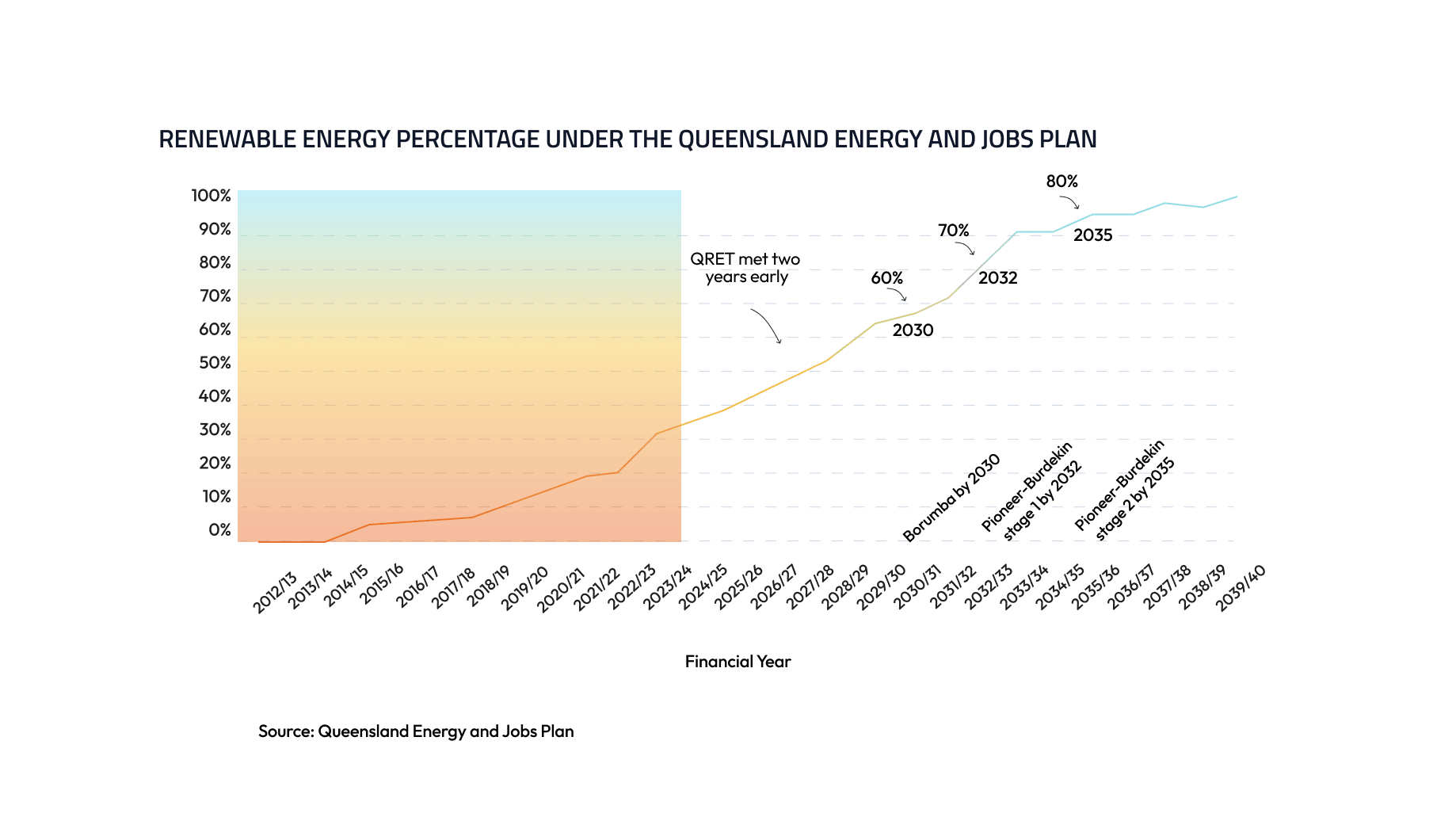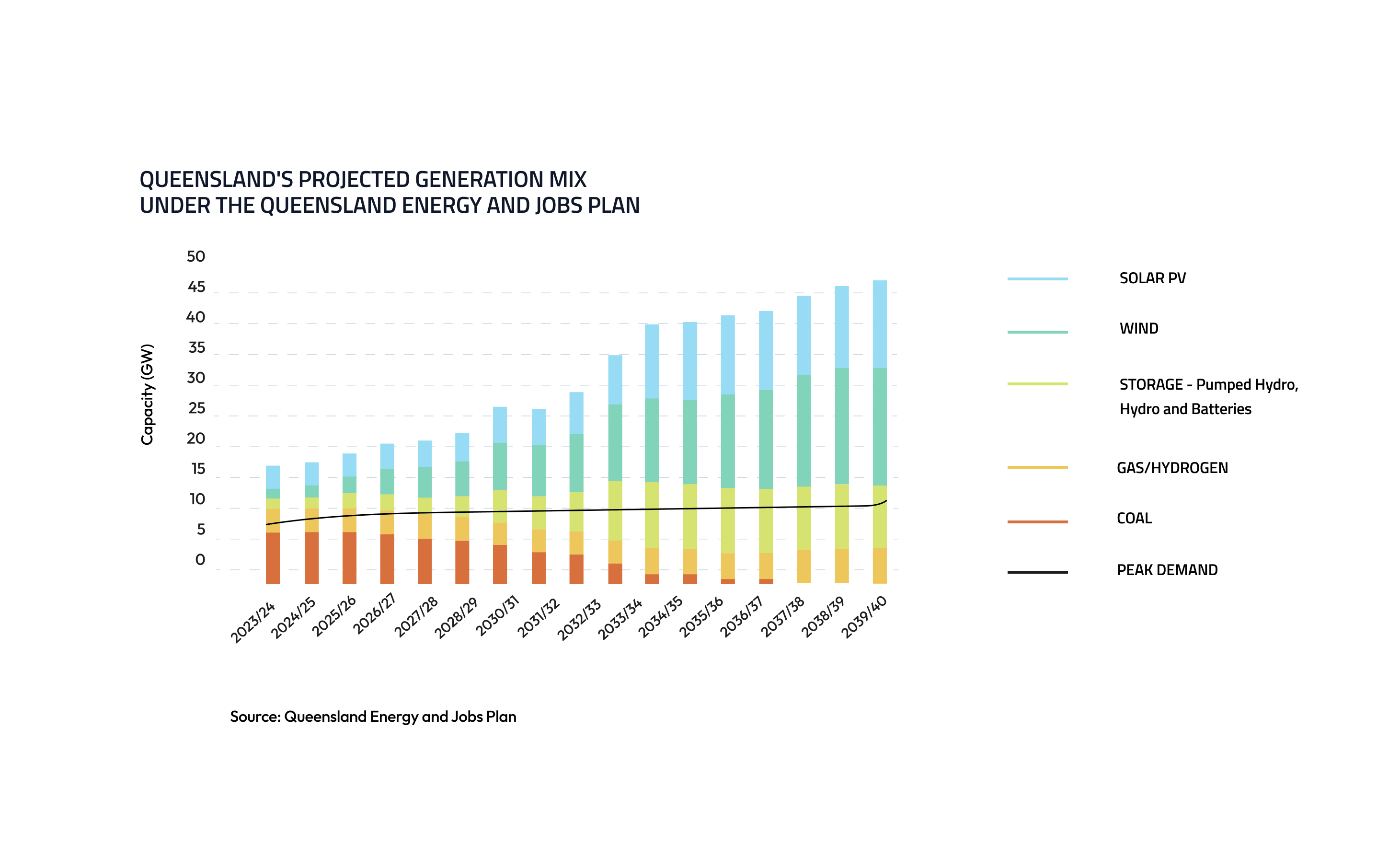How Queensland can reach 80 per cent renewable energy by 2035
How Queensland can reach 80 per cent renewable energy by 2035

Australia’s move to renewable energy is driven by the ultimate national goal of being net zero by 2050. This goal is supported by the states’ individual renewable energy plans, and transition plans for our energy workforce. To support this transition, the Queensland Government has an ambitious plan for 80 per cent of the State’s power to come from renewable sources by 2035. Here’s how it works.
The Queensland Energy and Jobs Plan, announced by Premier Annastacia Palaszczuk in 2022, represents $62 billion of investment in the energy system up to 2035.
Currently, about 26 per cent of the electricity used in Queensland comes from renewables. Queensland had previously set a target of 50 per cent renewables by 2030, but under the Queensland Energy and Jobs Plan, the state’s new targets are 70 per cent renewable energy by 2032 and 80 per cent by 2035.
A draft Renewable Transformation Bill has been prepared to legislate these targets.

The shift to renewables is expected to see Queensland reach a 50 per cent reduction in electricity sector emissions on 2005 levels by 2030, and a 90 per cent reduction by 2035-36. (The use of 2005 as a benchmark is in keeping with longstanding emissions targets.)
So, how will Queensland meet these targets? Here’s what you need to know about the State’s transition to renewables, outlined by the Queensland Energy and Jobs Plan.
Building the SuperGrid
At the core of the State’s transition to renewables is the Queensland SuperGrid – all of the elements of the electricity system, including transmission, solar, wind, dispatchable capacity and storage, that will provide Queenslanders with clean, reliable and affordable power for generations.
The government will invest $285 million to begin building the transmission that will provide the backbone for the grid, including 1500 kilometres of high-voltage transmission lines from Brisbane to North Queensland and out west to Hughenden. Powerlink, the state-owned transmission system operator, will also invest $365 million for grid upgrades in Central Queensland.
These investments will cut down on congestion and reduce transmission loss, allowing more wind and solar power and dispatchable storage to be connected to the grid.
It’s expected that 22 gigawatts (GW) of large-scale wind and solar power will be connected to the grid between now and 2035, adding to the 3GW that are already connected and supplying households and businesses with renewable energy today. This additional 22GW includes the Tarong West wind farm to be located 30 kilometres southwest of Kingaroy, which will become Australia’s largest publicly owned wind farm once final approval is obtained.
The Plan also includes low to zero emission gas as an economical way to firm the future renewables SuperGrid. A 200 megawatt (MW) hydrogen-ready gas peaking power station at Kogan Creek to help firm the grid, and a $20 million commitment to supercharge Queensland’s renewable hydrogen hubs and review the Queensland Hydrogen Industry Strategy in 2023, are included in the plan.
The government will also invest $500 million in grid-scale and community batteries, including flow batteries that can be manufactured in Queensland with locally sourced minerals, so the grid remains reliable and resilient when the sun isn’t shining and the wind isn’t blowing.
A further $42 million is expected to be invested in charging infrastructure to support the efficient integration of electric vehicles into the grid.
With one in three homes now using solar panels, Queensland already has the highest rate of household rooftop solar installations in Australia. The SuperGrid will help to integrate and coordinate these resources, and ensure that Queenslanders get the most out of their investments.
The Plan is projected to drive wholesale electricity prices 15 per cent lower on average by 2040 than they would be without a Plan. It also includes $10 million in funding to help Queenslanders save on their electricity bills, including support to help improve access to energy efficiency advice and devices.
Queenslanders experiencing vulnerability, and those who have had limited engagement with the energy system, including renters, will be prioritised, to ensure all Queenslanders benefit from the Plan – not just home owners.
Setting the standard for pumped hydro storage
Under the Queensland Energy and Jobs Plan, Queensland will be home to the world’s largest pumped hydro facility.
Hydroelectricity is generated by releasing water from an upper reservoir into a lower reservoir, and passing it through a turbine on the way. The force of the falling water causes the turbine’s blades to rotate, spinning a generator that produces electricity.
Pumped hydro takes this process a step further. In a pumped hydro facility, electricity from the grid or directly from nearby renewables is used to pump water from the lower reservoir back up to the upper reservoir at times when demand for energy is low and supply is plentiful.
When energy is needed, water is released from the upper reservoir back into the lower reservoir, once again generating energy as it passes through the turbine.
Hydroelectricity can be generated almost immediately, and at any time. Essentially, by consuming and producing energy strategically, it acts like a giant battery, storing energy until the grid requires it.
The Queensland Energy and Jobs Plan includes over $270 million to progress two world-class pumped hydro facilities – the Pioneer-Burdekin Pumped Hydro west of Mackay, and the Borumba Pumped Hydro west of Gympie.
The Borumba facility will be able to generate 2GW, enough to provide power for two million homes, but it’s dwarfed by the Pioneer-Burdekin facility, referred to by the Premier as “the battery of the north”, which is set to be the largest pumped hydro storage facility in the world at (up to) 5GW.
Collectively, the two projects would give Queensland the most hydro storage of any state in Australia.
Pumped hydro is generally capable of storing larger amounts of energy for longer periods of time than batteries, making it a better and lower cost option for overnight and long-term storage.
Both sites are subject to environmental assessments. If these projects and the others proposed under the Queensland Energy and Jobs Plan proceed, the following graph demonstrates how Queensland’s generation mix will transform to include more wind, solar and storage, while ensuring peak demand is always met.

Establishing clean energy hubs
By 2035, when renewable generation and pumped hydro storage has progressed to the point that Queensland is no longer reliant on coal, the state’s coal-fired power stations are expected to be operating as clean energy hubs.
Taking advantage of the existing transmission infrastructure at these sites, the hubs will be home to grid-scale batteries, as well as gas (and later hydrogen) power stations. They will also serve as maintenance hubs for nearby government-owned renewable wind and solar farms.
The coal-fired power stations will continue to serve in a back-up capacity for as long as required, and the large spinning generators at the stations will progressively be converted to synchronous condensers, enabling them to continue to provide inertia and strength for the grid, for as long as required.
A Queensland Energy System Advisory Board will be established in 2025, and will provide technical advice to government through a comprehensive review of the Plan every two years to ensure affordability, reliability and security is maintained as the system transforms.
Creating jobs
The Queensland Energy and Jobs Plan will support the creation of nearly 100,000 jobs by 2040, according to modelling by accounting firm Ernst and Young.
Approximately 64,000 jobs are expected to come from building the SuperGrid, while another 36,000 jobs are projected to result from green growth opportunities across key sectors of the economy.
To support workers at coal-fired power stations, the state government has established an Energy Workers Charter and Jobs Security Guarantee, which will be backed by a $150 million funding commitment.
The jobs security guarantee will provide workers with access to reskilling, transfers to new opportunities and advice on future career pathways.
“That ensures workers will have the opportunity to continue careers with publicly owned energy businesses or elsewhere in the public sector,” the Premier said.
A further $90 million will go towards building new regional transmission and training hubs in Gladstone and Townsville.
The government will also establish a Queensland Renewable Jobs Advocate to provide advice on the future skills, opportunities and training pathways required.
Funding the Plan
The government says the Queensland Energy and Jobs Plan will be funded between the public and private sectors. $6 billion has already been committed by the Queensland Government.
The existing $2 billion Queensland Renewable Energy and Hydrogen Jobs Fund will be boosted to $4.5 billion, with an injection of $2.5 billion from coal royalties. Though Queensland will gradually become less reliant on coal to generate energy, the Premier said export demand for coal will remain strong – especially for the metallurgical coal needed for steel production.
Demand for Queensland’s renewable hydrogen exports is also expected to increase as other countries set their own renewable energy targets.
In the State’s 2022 announcement of the Plan, the Premier said a detailed treasury analysis found the investment required to fund the Plan wouldn’t affect Queensland’s credit rating, and would still leave the state with a lower net debt than New South Wales or Victoria.
Under the Queensland Energy and Jobs Plan, Queensland’s energy system will remain majority-owned by the state, with returns coming back to Queenslanders.
To learn more, refer to the Queensland Energy and Jobs Plan from Queensland Government.
Subscribe to our newsletter
STANWELL SPARK
Receive news from Stanwell to your email every quarter and learn more about how we are transforming energy generation.